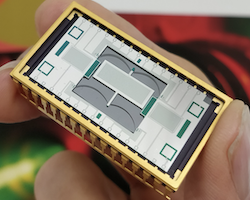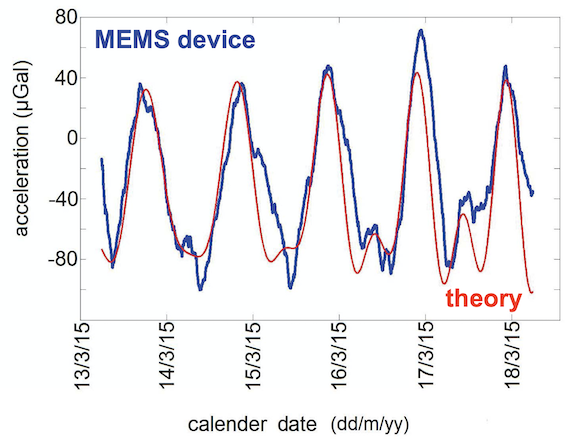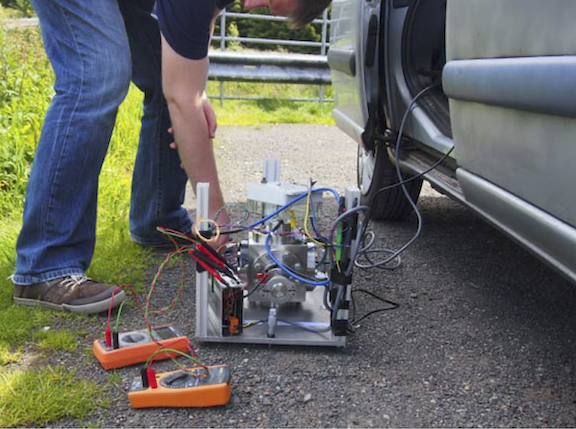MEMS Gravimeters and Gradiometers
Packaged MEMS gravimeter

First earth tide measurements by MEMS sensor

First MEMS gravimeter field trails

We have been working with Giles Hammond and colleagues in the Institute for Gravitational Research to develop miniature MEMS gravimeters using the same technology that produces the gyroscope in smart phones.
Gravimeters measure the change in gravity using Newton's law of gravity. The device is a mass on a spring using silicon for both. The gravitational force is proportional to the product of the mass of the object being measured and the mass of the gravimeter proof mass divided by the square of the distance between the devices.
Such gravimeters are used to characterise geological strata which are used for oil and gas prospecting, detecting sink holes, detecting old mines and for imaging greenfield and brownfield building sites to identify anomalies. We have developed a 12 mm x 12 mm x 0.2 mm MEMS gravimeter chip using anti-springs to reduce the resonant frequency to 1.8 Hz which significantly increases the sensitivity and stability over MEMS accelerometers. Our first MEMS gravimeter achieved 40 µGal/√Hz (about 40 ng/√Hz) which allowed the earth tides to be measured and we are presenting engineering a field portable demonstrator.
A number of projects undertaking field trials are now in progress including the EC project Newton-g testing an array of MEMS gravimeters on Mount Etna in Italy to see if the movement of magma in the volcano can be imaged. Further field trails aim to demonstrate gravity measurements on a range of moving platforms including UAV drones.
- "Measurement of the Earth tides with a MEMS gravimeter" Nature 531, Issue 7596, pp. 614 - 629 (2016) - DOI: 10.1038/nature17397
R.P. Middlemiss, A. Samarelli, D.J. Paul, J. Hough, S. Rowan and G. D. Hammond - "A 19 day earth tide measurement with a MEMS gravimeter" Scientific Reports 12, 13091 (2022) - DOI: 10.1038/s41598-022-16881-1
A. Prasad, R.P. Middlemiss, A. Noack, K. Anastasiou, S.G. Bramsiepe, K.Toland, P.R. Utting, D.J. Paul and G.D. Hammond - "Field Tests of a Portable MEMS Gravimeter" Sensors 17(11), pp. 2571_1 - 12 (2017) - DOI: 10.3390/s17112571
R.P. Middlemiss, S.G. Bramsiepe, R.A. Douglas, J. Hough, D.J. Paul, S. Rowan, G.D. Hammond - "A High Stability Optical Shadow Sensor with Applications for Precision Accelerometers" IEEE Sensors Journal 18(10), pp. 4108-4116 (2018) - DOI: 10.1109/JSEN.2018.2818066
S.G. Bramsiepe, D. Loomes, R.P. Middlemiss, D.J. Paul and G.D. Hammond - "Microelectromechanical system gravimeters as a new tool for gravity imaging" Philosophical Transactions of the Royal Society A 376, 2120 (2018) - DOI: 10.1098/rsta.2017.0291
R.P. Middlemiss, S.G. Bramsiepe, R. Douglas, S. Hild, J. Hough, D.J. Paul, A. Samarelli, S. Rowan, G.D. Hammond, - "Development of a MEMs gravimeter for drone-based field surveys" EGU General Assembly Conference Abstracts p 20906 (2020) - DOI: https://meetingorganizer.copernicus.org/EGU2020/EGU2020-20906.html
E. Passey, G. Hammond, S. Bramsiepe, A. Prasad, R. Middlemiss, D.J. Paul, R. Walker, A. Noack and K. Anastasiou - "Measurement of acceleration" US Patent No. US 10,802,042B2, 13th October 2020
P. Campsie, G.D. Hammond, R.P. Middlemiss, D.J. Paul and A. Samarelli


